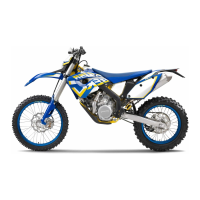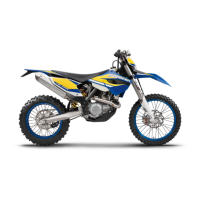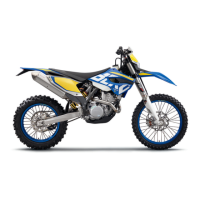Do you have a question about the HUSABERG FE 501 EU and is the answer not in the manual?
Explains various symbols used throughout the manual.
Details the typographical formats employed in the document.
Defines the proper and intended use of the Husaberg motorcycle.
Provides essential safety guidelines for operating the vehicle.
Explains danger levels and associated warning symbols.
Warns against tampering with noise control system components.
Outlines crucial practices for safe vehicle operation.
Emphasizes the necessity of wearing appropriate protective gear.
Addresses environmental considerations during motorcycle use and disposal.
Highlights the significance and proper use of the owner's manual.
Details warranty conditions and service requirements.
Guidelines for handling fuel, lubricants, and other fluids.
Recommends using approved spare parts and accessories for safety.
Stresses the importance of adherence to service intervals for longevity.
Information on obtaining assistance from authorized dealers.
Illustrated view of the motorcycle's front left side with component labels.
Illustrated view of the motorcycle's rear right side with component labels.
Identifies the location of the motorcycle's chassis number.
Indicates the location and purpose of the vehicle's type label.
Pinpoints the location of the engine identification number.
Shows where the fork component part number is stamped.
Identifies the location of the shock absorber component part number.
Describes the operation and location of clutch and hand brake levers.
Explains the throttle grip and the kill switch function.
Details the operation of horn, light, and turn signal controls.
Explains the electric starter and emergency OFF switch functions.
Interprets the various indicator warning and status lamps.
Instructions for opening and closing the fuel filler cap.
Describes the location and function of the idle speed adjustment screw.
Explains the operation of the shift lever and foot brake lever.
Details the use and securing of the motorcycle's side stand.
Explains how to lock and unlock the motorcycle's steering.
Identifies speedometer components and how to activate it.
Explains display messages and initial setup procedures.
Guides on setting distance units (km/miles) and the clock display.
Describes how to set and reset the service interval indicator.
Details displaying trip distances, average speed, and operating hours.
Provides essential advice for the first ride and break-in period.
Outlines the recommended steps for running in the engine properly.
Explains necessary preparations for riding in challenging terrains or weather.
Specific preparations for riding on dry sandy surfaces.
Specific preparations for riding on wet sandy surfaces.
Specific preparations for riding on wet and muddy terrain.
Preparations for riding in hot conditions at low speeds.
Preparations for riding in cold temperatures or snowy conditions.
Lists essential checks to perform before riding the motorcycle.
Details the correct steps for starting the engine safely.
Guides on how to start moving and shift gears smoothly.
Explains proper braking techniques for various conditions.
Provides instructions on how to safely stop and park the motorcycle.
Guidelines for securing and transporting the motorcycle.
Instructions on how to safely refuel the motorcycle.
Outlines the recommended maintenance schedule based on operating hours.
Lists optional service tasks available as per customer order.
Explains how to adjust suspension based on rider weight for optimal handling.
Details the adjustment of low-speed and high-speed compression damping.
Guides on adjusting the rebound damping of the rear shock absorber.
Describes the procedure for measuring static and riding sag.
Instructions for adjusting the rear shock absorber's spring preload.
Explains how to adjust compression and rebound damping on the front forks.
Details how to adjust the handlebar position for rider comfort.
Procedures for safely raising and removing the motorcycle from a lift stand.
Steps for bleeding fork legs and cleaning dust boots.
Instructions for loosening and positioning the fork protectors.
Procedures for removing, installing, and checking triple clamps and bearings.
Steps for removing and installing the front fender.
Guides on how to remove and install the rear shock absorber.
Instructions for removing and mounting the motorcycle seat.
Procedures for removing, installing, and cleaning air filter components.
Steps for removing, installing, and changing the silencer's filling.
Instructions for removing and installing the fuel tank.
Covers checking chain tension, cleaning, and checking for wear.
Guidelines for checking the frame and swingarm for damage.
How to check and correct the routing of the throttle cables.
Covers checking/securing rubber grips and adjusting clutch lever.
Procedures for checking and changing hydraulic clutch fluid.
Instructions for removing and installing the engine guard.
How to check and adjust the free travel of the hand brake lever.
How to adjust the basic position of the hand brake lever.
Guidelines for checking brake disc thickness and for damage.
How to check and add front brake fluid.
Instructions for checking and changing front brake linings.
How to check and adjust the free travel of the foot brake lever.
How to adjust the basic position of the foot brake lever.
How to check and add rear brake fluid.
Instructions for checking and changing rear brake linings.
Procedures for removing and installing the front wheel.
Procedures for removing and installing the rear wheel.
How to check tires for damage, wear, and age.
Guidelines for checking and correcting tire air pressure.
How to check and adjust spoke tension for wheel integrity.
Instructions for removing, installing, and charging the battery.
How to change main and individual power consumer fuses.
Procedures for removing, installing, and adjusting headlights.
Guides on changing headlight and turn signal bulbs.
Steps for replacing the battery in the speedometer.
How to check coolant and antifreeze levels and quality.
Procedures for draining and refilling the cooling system.
How to check and adjust the throttle cable play for smooth operation.
Procedure for setting the engine's idle speed.
Guides on checking and adjusting the shift lever's basic position.
Instructions for changing the fuel screen.
How to check the engine oil level and add oil if necessary.
Procedures for changing engine oil, oil filter, and cleaning oil screens.
Detailed steps for cleaning the motorcycle safely and effectively.
Steps for maintaining the motorcycle during winter operation.
Guidelines for preparing and storing the motorcycle for extended periods.
Steps to take to prepare the motorcycle for riding after storage.
Lists key technical data for the motorcycle's engine.
Provides torque values for various engine components.
Details capacities for engine oil, coolant, and fuel.
Technical data related to the motorcycle's chassis, suspension, and dimensions.
Technical data for electrical components like battery, fuses, and lights.
Information on tire types and pressures.
Detailed specifications for the front fork and rear shock absorber.
Torque values for various chassis mounting points.
Details the required DOT specifications for brake fluid.
Specifies recommended coolant types and mixture ratios.
Lists recommended engine oil types and specifications.
Specifies the required fuel grade and ethanol content limitations.
Lists recommended agents for cleaning air filters.
Recommends products for chain cleaning and lubrication.
Lists recommended cleaners for paints, metal, rubber, and plastic.
Lists recommended fuel additives and types of grease.
Explains the JASO T903 MA standard for motorcycle oils.
Explains the SAE classification system for oil viscosity.
| Displacement | 510.4 cc |
|---|---|
| Transmission | 6-speed |
| Seat Height | 970 mm |
| Fuel Capacity | 9.5 L |
| Bore x stroke | 95 mm x 72 mm |
| Fuel system | Electronic fuel injection (EFI) |
| Front suspension | WP Suspension 4CS USD |
| Rear suspension | WP Suspension PDS shock absorber |
| Front brake | Disc brake, 260 mm |
| Rear brake | Disc brake, 240 mm |
| Starter | Electric starter |
| Engine Type | Single cylinder, 4-stroke |
| Engine | Single cylinder, 4-stroke |











